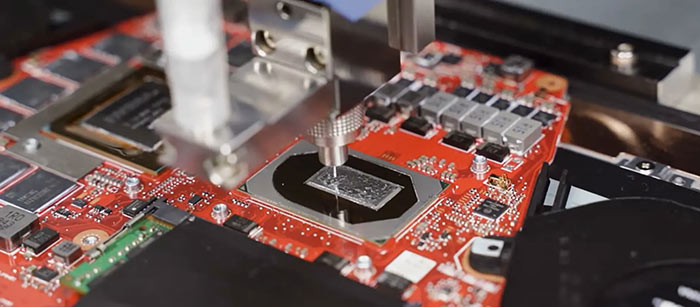Last week Intel launched its 10th Gen Core H-series CPUs for gaming and creator laptops. One of the first new laptops we looked at featuring the Comet Lake-H processors was the Asus ROG Zephyrus Duo 15 gaming laptop. Asus has revealed that the entire 2020 lineup of ROG gaming laptops with 10th Gen Intel Core processors have a special secret sauce so they can provide optimal performance and be effectively cooled - Conductonaut from Thermal Grizzly.
As seasoned enthusiasts and OC experts will attest, using 'liquid metal' thermal paste isn't as straight forward as the traditional compounds. Firstly liquid metal, as per the name, can flow away / out of the area you wish to cool, secondly it is electrically as well as thermally conductive so hazardous to spill, and thirdly it reacts with aluminium which might feature in some of your PC components. However, the prize is worth it for some, if mitigations and precautions are taken - excellent heat conductivity between processor and cooler.

Asus began its liquid metal experiments with the ROG Mothership and ROG G703 laptops a year ago. At that time it was using experienced production operatives to apply the compound correctly. Since that time it has been working on automating the process for the benefits of consistency, accuracy, and cost. After trying multiple combinations of production line machinery Asus has settled on the following process:
- The die is set into a stainless steel shim
- A 'special sponge' of 0.1mm height surrounds the die
- A mechanized arm wets its brush in a container of liquid metal and then glides back and forth across the CPU
- The above happens 17 times, in a natural painting arc
- A stainless steel nozzle adds two more drops of liquid metal
- A silicon 'brush' design (chosen from 30 alternatives) spreads the compound
- The cooler is fixed into place
Asus notes that Intel CPUs have a restricted area around the die that is completely free of capacitors, making them suitable for this process.
Patents have been filed by Asus with regard to the liquid metal application process and sponge barrier. ROG laptops with Thermal Grizzly Conductonaut liquid metal will be available in Q2 of this year.
As an aside, overclocker Der8auer recently took possession of an Asus ROG Zephyrus G14 (AMD Renoir processor) and manually upgraded with liquid metal - see the video embedded below. This laptop's performance enjoyed an uplift that meant it could achieve the same single core Cinebench R20 score as the desktop R7 3600X - and Der8auer was impressed.













